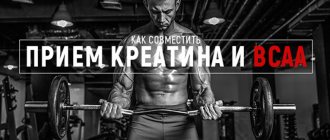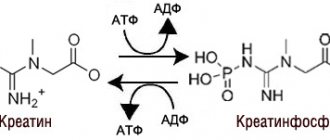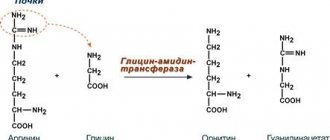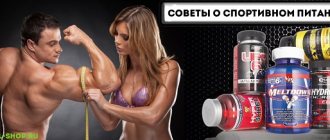The principle of the effects of additives
Creatine is synthesized from substances that, in turn, take part in the process of energy metabolism. If loading with creatine is carried out correctly, then more than 1 gram of muscle accumulates for every kilogram of human weight. Such chemical reactions occur in any person, even if he does not play sports, only in small quantities. Using creatine, the body quickly absorbs carbohydrate compounds and converts them into energy, which helps the body withstand heavy loads.
Due to the fact that the body can independently produce creatine only in small quantities, most often this is not enough for full training and recovery after it. Creatine loading helps in such situations. When used extremely correctly, the athlete's strength increases by more than 18 percent. This supplement is especially beneficial for those involved in strength sports.
Creatine: the effectiveness of taking creatine supplements depending on the type of training
Creatine and strength training A feature of strength training is the use of maximum weights and a small number of repetitions 1-6, on average 2-4 repetitions.
First of all, it should be noted that when performing (hard) work, creatine is consumed by the body only for a certain amount of time - the first 10-12 seconds. Then the energy supply mechanism, anaerobic glycolysis (the breakdown of glycogen), is launched, and the creatine system gradually “passes the baton” to anaerobic glycolysis. The high level of creatine in muscle fibers allows you to use all possible strength potential in this particular time range.
As noted above, creatine is actively consumed only in 10-12 seconds, and the higher the load (working weight), the faster the muscles consume creatine. A lack of this compound causes early muscle failure.
To put it bluntly, you will not be able to perform a set of 5-6 reps with a relatively heavy barbell if your creatine level is insufficient. Additional intake of a creatine supplement will allow you to improve your strength performance, as a result of which you will be able to fully work out 5-6 repetitions with this weight, however, this rule does not apply to 10-12 or more repetitions, since in this type of training muscle contractions occur only due to anaerobic glycolysis. The participation of creatine in this type of training is not taken into account.
Creatine and “bodybuilding” training We call “bodybuilding” the type of training in which professional bodybuilders work. This is 8-12 repetitions with weights that are approximately 80% of the maximum.
If you only work in the bodybuilding rep range (8-12), then creatine supplements will not have a noticeable effect, even for beginners, because this is how the energy supply mechanism for muscle work works in humans.
Let's repeat: supplements with creatine will allow you to push yourself to the limit only in 4-6 repetitions, with near-maximum working weights. If you perform a long bodybuilding set, you will have to reduce the total weight of the barbell or dumbbell, as a result of which your own creatine reserves will be sufficient.
Taking into account what has just been said above, one significant clarification should still be made. The fact is that there are already several new studies that prove the effectiveness of taking creatine even when training for 10-12 repetitions!
Of course, with this type of training, creatine will not increase strength characteristics, but it can help improve productivity, that is, strength endurance!
As it turned out, a high level of free creatine in the blood allows you to prolong the peak moment of anaerobic glycolytic muscle work. The fact is that creatine molecules are buffers of hydrogen ions, a byproduct that is formed during the breakdown of glucose. The abundance of hydrogen ions inhibits the enzymatic activity of muscles, as a result of which acidification with lactic acid (lactate) and, accordingly, muscle failure occur somewhat faster. At the same time, the presence of high levels of creatine makes it possible to delay this moment. So, additional intake of appropriate supplements, even in such a purely “bodybuilding” range of 8-10-12 repetitions, can improve the overall productivity of the training.
There is also a recent hypothesis that high levels of free creatine affect muscle growth.
There was a study that found little association between supplementation and muscle growth, but no actual increase in strength. In addition, it should be noted that creatine is involved not only in muscle energy metabolism, but also in other metabolic processes. We will not go into the jungle of biochemistry; we will only note the importance of the “creatine-phosphate shunt” system (in some translations: creatine-phosphate shuttle). Creatine and “cutting” training Cutting is a type of training whose task is to remove the maximum amount of fatty tissue while maintaining as much muscle tissue as possible (during “drying” a certain amount of muscle tissue is also removed).
“Drying” training is characterized by a high number of repetitions per set – from 12. So, understanding the mechanism of energy supply for muscle work, we note that using creatine during “drying” is useless. In addition, during drying, the body suffers from an incorrect water-salt balance, and taking creatine only suppresses this condition, since creatine is an osmotic substance in structure. Results Use creatine only for strength and semi-strength training: from 3-4 repetitions to 10-12 - maximum.
It is worth noting that the 8th and 9th repetitions are performed both due to creatine and due to anaerobic glycolysis. These are a kind of intermediate repetitions, during which the energy supply mechanism switches to higher levels of use of energy sources. Now let’s look at the question of the effectiveness of taking creatine supplements depending on your training experience.
Which type of creatine is best?
According to experts, a creatine supplement is considered the best if it does not contain foreign impurities. This type of sports nutrition product is natural. Science, as well as sports medicine, is developing every year, new products are being invented. In this regard, many newcomers to sports ask questions: “What is creatine? Loading? How to take this product correctly?
In order to avoid mistakes and overdose when taking the supplement, you should consult with specialists. It is important to remember that each sport requires a different type of creatine. The coach will determine the variety that the beginning athlete needs to take. The result in achievements will depend on this. The key to taking creatine is choosing whether to take it with or without loading.
When is the best time to take creatine?
In order for training to be extremely effective, it is necessary to monitor nutrition and time intervals. This factor directly affects the results. For this reason, you need to carefully approach your food intake. It should be distributed so that creatine is better absorbed. It is important to remember that the best time to take supplements is after intense training. During this period, blood flow in the veins improves and metabolic reactions intensify.
If an athlete is a beginner, the first thing he should do is decide how to take creatine without loading, so as not to harm his body. In such situations, you should reduce your intake of the sports supplement. Before starting an intense workout, you should not drink creatine, as it may upset the balance of water in the body.
During rest days, supplements should be taken in the morning. This is because at this time of day the body is saturated with growth hormones. Creatine improves metabolism, thereby allowing the carbon element to penetrate directly into the muscles.
Creatine: application features and dosage
Content
Creatine is one of the most popular nutritional supplements designed to increase muscle mass, strength and endurance. Used by professionals and amateurs of both sexes, it is also useful for women. The most effective form of creatine monohydrate is considered to be in powder form. Also available in tablets, capsules, and liquid.
Creatine is produced in small quantities by the human body and comes with food (red meat). But this is not enough to maintain the required level, and it is destroyed quickly. The diet of every physically active person should include creatine monohydrate as a dietary supplement. The optimal daily intake for an adult is on average 5–7 g of pure creatine. It is calculated individually depending on the method of application and the desired results.
Monohydrate is the popular and purest form of such effective, important and beneficial creatine.
The supplement is definitely useful and safe. Side effects from creatine are extremely rare:
- water retention in the body;
- dehydration;
- indigestion;
- spasms and cramps;
- acne on the skin.
Numerous studies have proven that these phenomena are not always directly related to creatine intake and do not cause significant harm to health. To minimize any unpleasant consequences, let’s figure out how to load with creatine correctly.
How to use creatine correctly
This type of sports nutrition has a low absorption threshold, so you need to know how to take creatine with a load for athletes of different sizes. The future result in achievements directly depends on how competently the choice is made. The correct choice of creatine dosage significantly increases the effect of the substance and also reduces the risk of side effects.
Consuming monohydrate with proteins allows you not only to gain muscle weight, but also to increase strength. These two natural components harmonize well with each other, which makes it possible to enhance the effect of the additives. Thanks to this, you can safely add a portion of creatine powder to the prepared protein shake. This technology of administration is best suited for athletes with an average body build.
For thin athletes, a mixture of gainers with monohydrate is most suitable. The method for preparing the supplements is exactly the same. Supplements of this type are good for building a sculpted body.
Taking sports nutrition without loading
You need to take creatine monohydrate without loading more than 6 g per day, which is about a teaspoon. On training days, creatine is consumed after the end of training for one hour. For better absorption of supplements in the human body, you need to mix creatine and a cocktail of proteins or carbohydrates before taking it.
When there is a daylong break between classes, creatine should be taken between meals throughout the day. Each time it is better to take monohydrate with complementary elements (protein, gainer or carbohydrates). This sports nutrition system should be maintained for two months. After this, a short break is required.
Safety and side effects
A number of studies show that creatine is safe in both the short and long term (, , , ).
According to the International Society of Sports Nutrition (ISSN), up to 30 grams of creatine per day for five years may be safe and generally well tolerated in healthy people ().
In rare cases, gastrointestinal problems such as nausea, vomiting and diarrhea may occur. Creatine can also cause weight gain and bloating because it increases water retention in the muscles (, ,).
Because creatine is metabolized by the kidneys, supplementation may impair kidney function in people with kidney failure. If you have impaired kidney function, consult your doctor before taking creatine ().
Although it is generally believed that creatine may increase the risk of dehydration, cramps, and heat illness, current research contradicts these claims.
In fact, some studies show that creatine may reduce dehydration, cramps, and the risk of developing heat-related illnesses (, , , ).
In general, creatine is safe when taken in recommended doses. As always, if you have a health problem or are pregnant or breastfeeding, you may want to consult your doctor before taking creatine.
Summary:
Research shows that creatine is safe and effective for healthy people when taken in recommended doses.
Use with loading
Creatine loading involves taking large amounts of supplements over 7 days. In the first seven days you need to consume 5 grams of powder 4 times a day. Supplements should be taken between meals.
On training days, you need to drink the diluted powder with a cocktail immediately after finishing your workout, within one hour. After a week of training in this mode, you should reduce the dose by 2 grams. This nutrition course is extended for exactly one month. Then a break of approximately 21 days is required.
Is this really necessary?
While the goal of the creatine loading phase is to increase your body's creatine stores, it may not be necessary to increase your overall creatine levels.
In fact, lower doses taken once daily may be equally effective at increasing muscle creatine stores—although it may take a little longer.
For example, one study found that muscles became fully saturated after people took 3 grams of creatine daily for 28 days.
Therefore, to maximize muscle creatine stores with this method, it may take you about three weeks compared to the loading phase. Therefore, you may have to wait to see the positive effect (, ).
Summary:
It is possible to completely saturate your muscles with creatine without going through a loading phase, although this may take longer. Thus, it may also increase the time it takes to get the effects of taking creatine.
Is Creatine Loading Necessary?
A lot of people wonder: Is creatine loading necessary? how to carry it out correctly? The answer is actually simple: it is necessary for athletes who seek to increase muscle mass, as well as results. If you take about 4 grams of creatine for a month, the results will be obvious without loading. By using it, you can achieve monthly results in just 7 days. At the same time, it is necessary to train intensively, only then will there be a good result.
The meaning of loading is quite simple: it speeds up metabolic processes. While taking the supplement, the athlete is well motivated and tries his best in the gym. It is important not to overdo it with the dosage and frequency. These actions can lead to side effects and wear and tear on the body. The daily norm for an athlete of average build is 20 g per day for a week. Accordingly, without loading the dose is significantly less.
Is creatine loading necessary: details about methods
In the sports environment, two methods of using nutritional supplements are common. They are both effective for building muscle mass, strength and endurance, increasing training productivity and pain-free recovery, but they differ fundamentally in their dosage regimen and goals.
Creatine monohydrate helps improve athletic performance not only in bodybuilding
This is about:
- loading with creatine;
- non-boot method.
What are they, and what is the best option to choose?
List of manifestations
In some situations, discomfort may arise from excessive use of creatine, that is, an overdose. This:
- disruption of normal digestion;
- the appearance of edema of varying severity;
- convulsions (occur very rarely).
These undesirable manifestations in most cases can occur during the period when creatine loading is carried out. Every athlete should remember how to take monohydrate at this time. By following all instructions for use, you can achieve good results without harming your health.











